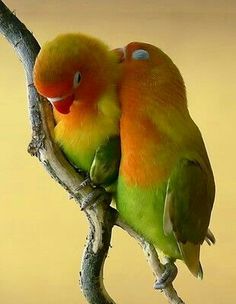Lovebirds are one of the most popular pet parrot species, which comes as no surprise to those familiar with them. These small birds, which are both beautiful and intelligent, have been one of the most popular African parrot species for over a century.
However, there are numerous myths regarding Lovebirds, their behavior, and what it’s like to have them as pets. If you want to learn more about Lovebirds, continue reading to find out some basic facts about these feisty little birds.
Lovebirds Normally Don’t Talk.
Although Lovebirds are a sort of parrot and can mimic human speech, they are not among the species that most people think of as talking birds.
This is because they rarely speak, and when they do, they usually replicate basic noises such as whistles or domestic sounds like doorbells and microwaves.
It is unclear why certain Lovebirds are more prone to copying speech than others, but it is usually assumed that those who do learn to talk are trained at a young age.
There Are Several Types of Lovebirds
There are many different types of Lovebirds. There are nine separate sub-species of these little parrots, each carrying their own distinct traits and characteristics.
These include the Masked Lovebird, the Black-Cheeked Lovebird, the Fischer’s Lovebird, the Nyasa Lovebird, the Swindern’s Lovebird, the Red-Faced Lovebird, the Abyssinian Lovebird, the Madagascar Lovebird, and the most well-known, the Peach-Faced Lovebird.
The Peach-Faced Lovebird is distinguished by a rainbow of yellow, green, and blue on its body and brilliant peachy-pink faces.
While the appearance and behavior of each variety of lovebirds vary, all Lovebirds can live in captivity for up to 20 years on average.

Lovebirds aren’t always best kept in pairs.
It is a widely purported myth that you should never own a solitary Lovebird and that if they are not kept in pairs, they will die of depression. While it is true that they are extremely social birds who thrive on interaction and must be socially stimulated, in many cases, bird owners should keep single Lovebirds.
This is because these birds breed easily in captivity, and most bird owners are unable to care for a large family of parrots.
It is also worth noting that birds raised in pairs tend to bond with one another and avoid human interaction.
Those who want their bird to be loving and open to being touched by humans have discovered that it is preferable to keep birds alone and spend as much time as possible playing and socializing with them to meet their demands.
Lovebirds Are One of the Smallest Parrot Species
While they are true parrots, Lovebirds are one of the smallest members of the parrot family.
Most Lovebirds reach maturity with a length of 5 to 7 inches, measured from the beak to the end of the tailfeathers.
Their small size has worked to push their popularity among those who live in apartments and other small spaces.
Many of these bird enthusiasts have found it easier to house and care for these small birds than to keep a larger parrot species like a Macaw or a Cockatoo.
Lovebirds Are Very Active
Like all parrots, Lovebirds are extremely active birds that need quite a bit of exercise to stay in top physical condition.
Those interested in adopting a Lovebird must be willing and prepared to provide their feathery friend with a bird-safe environment to play outside of its cage for several hours each day.
will allow the bird to exercise all of the muscle regions that it requires to keep healthy, as well as give the necessary cerebral stimulation for these highly clever birds.
Remember that lovebirds are incredibly busy birds.
A minimum of 32″ x 20″ x 20″ (81 x 50 x 50 cm) is recommended for each pair of birds, with approximately four perches, feed and water dishes, and a bath place. Place the cage on a stand or hang it from a wall bracket at eye height or approximately 6 feet off the floor.
Make sure the location you choose has sufficient lighting and is properly aired, but free of drafts.
It should be located away from doorways and windows, where direct sunshine might make it too warm, yet close to at least one wall to create a sense of security.
Average daily temperatures can range from 60°F to 70°F, with overnight temperatures as low as 40°F. As a general guideline, the ambient temperature that you find pleasant should be appropriate for your bird.
Whether your bird is sick or healthy, keep an eye out for these telltale indicators of temperature-related discomfort: Cold birds frequently remain fluffed up for extended periods of time, but overheated birds keep their wings away from their bodies and pant.
The cage should be covered at night to keep out drafts and distractions. Lovebirds want special resting areas.
Nest boxes positioned high, at the same level, and of the same type are effective in preventing battles. A lovebird nest box measures 8 x 8 x 8 inches (20 x 20 x 20 cm) or 10 x 6 x 6 inches (25 x 15 x 15 cm). Check for eggs and remove them immediately to avoid overcrowding. Remember that there are already so many homeless animals out there!
Problems
Signs of illness include a bird that appears withdrawn, has ruffled feathers and drab plumage, sits with its eyes closed for long periods, has watery or dull eyes, a runny nose, sleeps a lot, loses interest in its surroundings, and lingers at its feed dish.
The droppings may change color and become loose (when healthy, they are grayish-white and not too thin).
There was also a lot of tail bobbing, dropping off its perch, unusual breathing, sneezing, and excessive scratching.
Some of the common illnesses that your lovebirds may contract include fighting injuries, Psittacine Beak and Feather Disease, Polyoma Virus Infection, yeast infections (Candidiasis), Avian Pox Virus Infection, bacterial infections, internal parasites, mites, ticks, egg binding, intestinal influenza, coccidiosis, respiratory ailments, and diarrhea.
An ailing bird should be taken to an avian veterinarian for diagnosis and treatment immediately!

